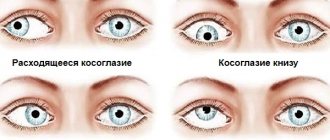People often notice that small moving objects begin to appear in their field of vision. Such objects can have completely different shapes: circles, dashes, lines, zigzags. But especially often, they take the form of completely ordinary floating black dots. What is it, how dangerous is it and can anything be done to get rid of such a scourge?
Actually, it all depends on the circumstances under which such points and objects appear in the field of view, as well as on their number or concentration. Very often, this does not pose any particular danger, but in some cases it can be a symptom of a dangerous disease that can not only significantly impair vision, but also cause complete blindness. Next, we will look at the main causes of this problem and the best options for getting rid of it without compromising the health of the eyes and the body as a whole.
Destruction of the vitreous body
As a rule, non-disappearing moving black dots may indicate the onset of destructive changes in the vitreous humor of the eyes. When light passes through, destructive elements can cast shadows on the retina. These shadows are seen by a person as peculiar objects and “sights” of different sizes and shapes.
In other cases, black dots may appear when casting a shadow:
- Blood clots (with hemorrhage in the eye);
- Crystal elements;
- Tumor cells.
Depending on the distance of the foci of opacification from the retina, floating objects appear stronger or weaker. At the same time, having made a movement with your eyes, you can notice that the points begin to move towards the direction of your gaze, and then smoothly return to their original position.
Causes
Corneal clouding usually results from traumatic or inflammatory damage to the structure, but sometimes the condition also occurs due to genetic disorders. The main causes and risk factors include:
- Corneal injury. The outer shell of the eye is very easily damaged - this can be caused by exposure to a foreign object entering the eye, as well as a chemical or thermal burn. Experience shows that even a small scratch can cause a scar to form. In addition, doctors note that in recent years, eye injuries are increasingly occurring due to improper wearing of contact lenses.
- Infection of a bacterial or viral nature. The disease is called keratitis.
- Vitamin A deficiency.
- Corneal dystrophy. This is a rare inherited condition.
- Keratoconus is an acute inflammatory disease in which the structure of the cornea changes. The disease is characterized by clouding and thinning of the outer membrane of the eye.
- Rare genetic diseases.
There are a large number of infectious diseases that can cause corneal clouding. The following main infections are distinguished:
- Conjunctivitis is a lesion of the outermost membrane of the eye that occurs due to invasion of infectious agents (bacteria or viruses) or an allergic reaction.
- Infection associated with improper lens wear. This disease is a consequence of insufficient cleaning of lenses or non-compliance with eye hygiene rules.
- Herpes zoster is a viral infection that affects various structures of the eye and also causes a rash on the face, head and neck. The disease also affects the condition of the cornea.
- Ocular herpes is an infection caused by the invasion of the herpes simplex virus (also known as oral or genital herpes).
- Complications of this disease often cause blindness.
- Neonatal infectious keratitis is a rare infection transmitted to the child from the mother. The causative agent may be herpes simplex virus or neisseria.
Thus, corneal opacification can be associated with a large number of pathologies with different etiologies.
Causes of destructive changes
As a rule, the destruction of the vitreous body is caused by age-related changes in the human body. Therefore, in most cases, moving black dots appear in the field of vision of older people. True, recently, a similar problem is increasingly occurring among fairly young people. Moreover, destruction of the vitreous body is not the only cause of its occurrence. The appearance of such visual interference can also result from:
- A rise or fall in blood pressure (hypertension, hypotension);
- Spasms of cerebral vessels, circulatory disorders, stroke;
- Prolonged visual stress;
- Smoking, drug addiction, excessive alcohol consumption;
- Vitamin deficiencies;
- Eye or head injuries;
- Gastrointestinal diseases, liver damage;
- Inflammation processes in the eye structures;
- Metabolic disease;
- Physical fatigue, stress;
- Prolonged oxygen starvation.
In any case, if floating black dots appear before your eyes, you should consult a doctor as soon as possible. First, schedule a visit to the ophthalmologist. And if his examination does not reveal ophthalmological problems, he will have to visit other specialists.
Dark or black spots
A dark spot on the cornea of the eyeball appears due to macular degeneration. It is associated with impaired blood supply to the vitreous body. The causes are usually bad habits and age-related changes in the body.
The disease is accompanied by decreased vision and pain. Dark areas gradually increase in size, indicating the progression of the disease. Lack of treatment leads to irreversible blindness.
Brown and black spots on the whites of the eyes occur against the background of impaired pigment metabolism. Melanocytes begin to intensively secrete melanin, which forms black spots on the eyes. It is observed in hereditary diseases and oncological pathologies.
Quite rarely, black dots on the whites of the eyes are formed due to a fungal infection. Aspergillus spores, a microscopic fungus, can enter the eyeball. There they grow, causing pain and blurred vision. It is extremely rare that the eye is affected by helminths - Toxocara or tropical parasites.
A dark spot on a child's eye is usually not a disease. This is a physiological process associated with a change in the color of the iris. The condition goes away with age.
If a black dot appears in the eye near the pupil, the person may have had an eye injury with damage to the iris. Its pupillary edge is torn, causing the pupil to lose its round shape.
Video: Removing a brown spot from the conjunctiva of the eye
Treatment methods
A thorough diagnostic examination by an ophthalmologist will determine what caused the appearance of black spots before the eyes and which treatment option will be preferable in a particular case. So, when you first contact a specialist, when the spots in front of your eyes are small in size and have low concentration in the field of view, the doctor usually prescribes therapy with certain eye drops. As a rule, these drugs are: Taufon, Quinax, Emoxipin or Wobenzym.
The properties of these eye drops help stimulate the metabolic processes that occur in the vitreous body. In addition, some of them have a resolving effect. It should be noted that it is extremely difficult to predict the effectiveness of treatment when using eye drops. For some patients, they really help, while others do not notice any positive dynamics at all.
If there is no effect of conservative treatment, the doctor may suggest a surgical way to get rid of this problem. In this case, it is necessary to soberly evaluate all the pros and cons, because moving black dots during the destruction of the vitreous body do not pose a danger to health or vision. Still, when they are extremely irritating, it is worth considering surgery.
The problem of black dots in the field of view can be solved in two ways:
- A vitrectomy operation, when the vitreous body is surgically removed partially or completely (in the most difficult cases). Serious complications are possible when performing this operation, so an appropriate expert opinion is required to perform it.
- Vitreolysis surgery. It is performed using a medical YAG laser. During the intervention, the ophthalmologist targets the elements that interfere with vision, literally fragmenting them into ultra-small particles, which in the future will no longer be able to interfere with vision.
Why does it appear?
A white or brown spot on the iris does not always indicate the development of a pathological process. Sometimes a person develops pigment spots in the iris area that do not require special treatment, provided that they do not cause discomfort and do not in any way affect the quality of visual function. There are the following reasons due to which spots may appear on the eyes in the iris area:
- Small hematomas. If a spot appears on the iris or pupil, this may indicate a slight hemorrhage. This spot is the size of a speck and is colored dark red. The deviation is caused by increased intraocular pressure or mechanical damage to the iris.
- Retinal detachment. Often small spots indicate a violation of such an ocular structure, as a result of which a person feels the presence of a foreign body.
- Nevus. Such neoplasms are benign in nature, and the site of formation of spots on the iris is of great importance. The deviation can appear at any age, and the speck is no more than 2 mm in size and has a flat shape.
- Leukoma. A disorder occurs due to an inflammatory reaction, mechanical damage to the iris, or after an incorrectly performed operation. Such a spot is usually called a cataract, which can be congenital or acquired.
- Cataract. The problem is characterized by clouding of the lens. In this case, a small white area forms on the cornea.
If a nevus has formed on the iris, then it is worth monitoring it regularly, since it often grows rapidly, which causes deformation of the pupils.
Risk factors
The appearance of pigment spots does not always indicate a disease.
Pathological causes do not always mean that the disease will necessarily manifest itself in a person. For a spot to form, a number of specific factors are required that contribute to the development of the disorder. A ring around the iris or small specks may appear under the influence of the following negative sources:
- increased melanin levels;
- hormonal imbalance in the body;
- adolescence;
- bearing a child;
- taking oral contraceptives;
- impaired metabolism;
- constant mental or physical fatigue;
- prolonged oxygen starvation.
Prevention measures
If floating black dots have just begun to appear in your field of vision. They still have a small number and do not reduce the quality of life, but they are already tiring with their presence, it is worth reconsidering the usual way of life. Perhaps by changing it, the problem will stop getting worse and there will simply be no reason to see a doctor. Here's what you need to change in your daily life:
- Become more active;
- Regularly engage in sports or physical activity;
- Be in the fresh air more often;
- Quit smoking;
- Do not abuse alcohol;
- Review your diet and ensure your body receives the required amount of vitamins and minerals;
- Get enough sleep;
- Limit visual stress.
Necessary treatment
For minor dysfunctions, drops are prescribed, for example, “Taufon”.
Appearances on the iris of the eye must be treated promptly if they cause cosmetic discomfort to the patient and negatively affect visual function. For minor disturbances associated with fatigue and other non-pathological factors, you can use medications. For spots on the iris, the patient is often prescribed the following eye drops, which quickly eliminate the problem:
- "Taufon";
- "Emokipin";
- "Quinax";
- Wobenzym.
If the deviation cannot be removed with the help of medications, then a radical therapeutic measure is required. Spots formed on the iris can be removed through vitriolysis. The procedure involves exposing the pathological neoplasm to a laser beam, which eliminates only damaged tissue without affecting healthy tissue. In particularly advanced cases, when the spot has grown to a large size and impairs vision, surgery is required.
In conclusion
The appearance of black dots before the eyes can be a clear signal from the body that it needs to take care of its health. Therefore, if such a problem arises, you should rush to see a doctor. And if the specialist does not find anything dangerous in the situation, be sure to try to change your usual lifestyle, making it more active and correct. And most importantly, take care of your eyes: do not overstrain them, protect them from bright light, avoid shocks and injuries. Then sharp vision is guaranteed for many years!
By contacting the Moscow Eye Clinic, each patient can be sure that some of the best Russian specialists will be responsible for the results of treatment. The high reputation of the clinic and thousands of grateful patients will certainly add to your confidence in the right choice. The most modern equipment for the diagnosis and treatment of eye diseases and an individual approach to the problems of each patient are a guarantee of high treatment results at the Moscow Eye Clinic. We provide diagnostics and treatment for children over 4 years of age and adults.
You can find out the cost of a particular procedure or make an appointment at the Moscow Eye Clinic by calling 8(499)322-36-36










